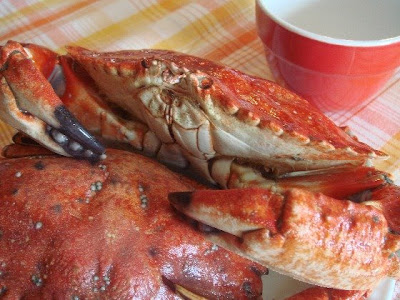Before the end of the hallowed dungeness crab season in the SF Bay Area, my husband and I put some sunscreen on, woke up at 5 in the morn', filled up our portable coffee mugs, and headed to the Pacifica pier. At least I heard that this is what we did. We cast our crab nets out in the expansive Pacifica bay and gave the local seal known for snatching crabs from people's nets the evil eye.
Although a dear friend of mine insists that a group of our friends and I fishing in a Clearlake trout farm where nearby "fisherman" started aiming at our finned buddies with bee-bee guns counted as true fishing, it did not. This was the first time I was successfully involved in plucking something from the water that ended up on my plate.
And I helped. I refilled our coffee.
I was very proud to take part in this crustacean encounter resulting in not one, or two, but three crabs! Three red crabs and one dungeness. From OUR net!
On the way home, with the fidgeting crabs tapping on the bucket wedged between my legs in the front passenger seat, we considered our dinner options. Crab fritters? Crab lasagna? Crab salad? Nah. We finally decided two simple preparations. The first was angel hair pasta, topped with chopped parsley, butter, and freshly cracked crustacean. The second was pure crab, dipped in a classic Vietnamese dipping sauce made of lime juice, sweet chili and fish sauce.
We just happened to an opened sample of wine and two samples sake from the shop at hand, so we decorated our crab adorned table with the three bottles.
What worked with what?
The wine was a Gascogne wine from Domaine Chiroulet in the southwest of France, made entirely of Ugni Blanc and Columbard. Bright, fresh, with hints of ripe grapefruit and lime, this crisp, mineral wine worked best with the Vietnamese dipping sauce. I thought that it would pair better with the buttery pasta, by cutting some of the richness of the butter and highlighting the sweet crab with its acidity, but it tasted so much better just with the crab dipped in the fresh dipping sauce. It matched the lime one-on-one and the ripe grapefruit qualities happily wrapped themselves around the chiles and touch of sugar.
And the buttery pasty? Sure it was great with the Gascogne white too, I must admit that it was better with the sakés. I know!
Now many of you were introduced to my husband, or at least his chile pepper chef pants, through the Prosecco and Peas post, but I'm guessing that even with this intro, most might not know that my husband is a sake lover who makes his own sake brew at home. Really good, Nigori-style sake. I like sake, but as the main man in my life is so much better suited to discuss the rice drinks with you than I am, I include his insights on the sake and crab pairings below. Enjoy. All accolades for our newest contributer may be left in the comment section of this blog, of course, adressed to me, as my ego is fragile.
Who Has Two Claws and Likes Sake?!
Chiyonosono: Shinriki (Sacred Power) Junmai Ginjo. Kumamoto Prefecture: SMV +2.5, Acidity 1.5.
Located in Yamaga City, which is known for many ancient burial sites, the area is also a well known hot spring resort location and is protected by the magnificent natural environs near Mt. Aso. The nose of this saké gives aromas of fresh-cut grass and hints of tropical fruits with cantaloupe being the frontrunner. The texture of this Ginjo is silky on the palate. A deep and rich yet mellow flavor, which is a little buttery and slightly sweet, with hints of mango and pear. The finish gives a little warmth from the alcohol, which is well appreciated after a hard day of crabbing. This saké paired well with the crab and Vietnamese dipping sauce.
Sudo Honke: Sato No Homare (Pride of the Village) Junmai Ginjo. Ibaraki Prefecture: SMV +3, Acidity 1.3.
This is the oldest active brewery in all of Japan, which was founded in 1147, based on the oldest records available. Mr. Sudo is the 55th generation of his family to brew sake and everything brewed here is junmai ginjo or junmai daiginjo, and almost all of it is unpasteurized. This saké’s appearance is clear with only a slight tinge of amber. It gives a light and fruity nose, laced with koji rice, strawberry, pear, violets and grape. This Ginjo is semi-dry and a little syrupy with refined and clear flavor, yet deep with a clean finish. This sake paired best with the dish of crab and buttery pasta.























